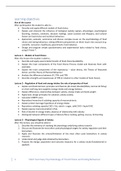Learning objectives
Aim of the course
After participation the student is able to…
• Describe and apply different models of food choice.
• Explain and interpret the influence of biological (satiety signals, physiology), psychological
(learning, memory, emotions, decision making), social (context and lifespan), and cultural
factors on food choice and nutrition behaviour.
• Appreciate, evaluate, summarise and discuss complex issues on the psychobiology of food
choice and eating behaviour, taking different perspectives on these issues into account (e.g.
scientific, consumer, healthcare, government, food industry).
• Design and program simple questionnaires and experimental tasks related to food choice,
using E-Prime ®.
Lecture 1 – Models of Food Choice
After this lecture the student is able to…
• Describe and apply several determinants of food choice/availability.
• Explain the main components of the Food Choice Process model and illustrate them with
examples.
• Explain the main components of the expectancy – value theory, the Theory of Reasoned
Action, and the Theory of Planned Behaviour
• Analyse the differences between EV, TRA, and TPB.
• Describe strengths and weaknesses of TPB (in relation to other models of food choice).
Lecture 2 – Regulation of food and energy intake: the role of properties of food
• Explain and illustrate basic principles and theories (de Graaf, Blundell/Mela, Herman & Polivy)
on short and long term appetite energy intake and energy balance.
• Explain differences, relationships between satiety, energy intake and body weight.
• Apply basic design principles for satiation, satiety studies.
• Calculate COMPX score.
• Reproduce hierarchy of satiating capacity of macronutrients.
• Explain protein leverage hypothesis of energy intake.
• Reproduce satiating capacity CHO > Fat; starch = sugar; solid CHO > liquid CHO.
• Explain passive overconsumption of fat.
• Role of alcohol in energy intake; absence of relationship with obesity.
• Distinguish between different types of dietary fibres: bulking, gelling, viscous, fermenting.
Lecture 3 – Physiological Signals of Satiety
After this lecture, you should be able to:
1. Describe the relevance of studying the physiology underlying satiety research.
2. Discuss and illustrate the most often used physiological targets for satiety regulation and their
biomarkers.
3. Apply and illustrate the criteria/limitation of the most often used biomarkers in satiety
research.
4. Understand and judge data obtained by biomarkers.
5. Propose the design, population and outcome measures for a satiety study (fundamental or
applied).
1 Short Summary Psychobiology of Food Choice and Eating Behaviour





